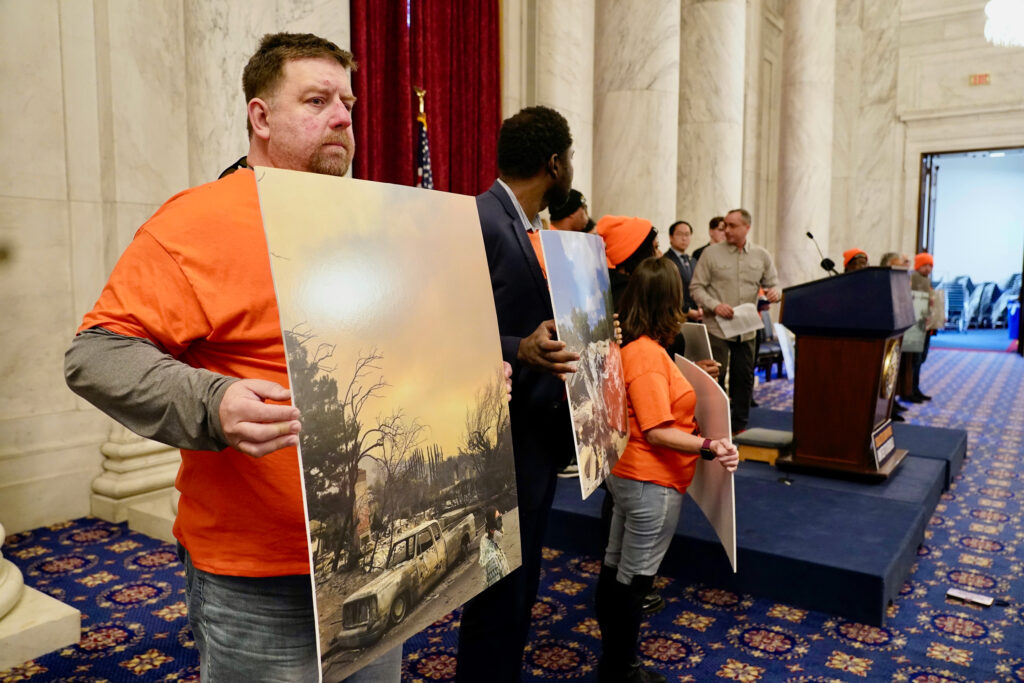LOUISVILLE, Ky.—When the U.S. Environmental Protection Agency responded to a “surface water pollution emergency” on farmland 17 miles south of downtown in 1979, federal officials joined state regulators in removing 17,000 barrels of hazardous waste from an illegal dump site. It would become notorious nationally as the “Valley of the Drums.”
But the EPA didn’t do anything about dozens of other hazardous waste containers strewn in a nearby forested hollow, about 700 feet away, in what eventually became dubbed the “Gully of the Drums,” even though a local court had ordered a cleanup.
At least twice since then—after EPA had declared the Valley of the Drums cleanup a success—Kentucky environmental regulators and EPA officials investigated the Gully of the Drums. They found pollutants lingering in the soil above health and safety levels that would normally spur a remediation.
But again, nothing was done, leaving what is now a public park preserved as a tribute to area veterans, the Jefferson Memorial Forest, unremediated to this day. Forty to 45 barrels remain in the woods, leeching what’s left of their toxic contents into the soil.
We’re hiring!
Please take a look at the new openings in our newsroom.
See jobs
These are the conclusions of new research by Sam Satterly, a 35-year-old Iraq War veteran who found records about the Valley of the Drums, and its country cousin, in a nearby public library and spent the past two years digging into them.
In December, Satterly completed her research on both dump sites as part of a master’s degree she earned in sustainability from the University of Louisville and has summed up her findings on a website she created. Her thesis has revealed previously untold stories about the origins of the Gully of the Drums—and how it shares some connections to Valley of the Drums.
Satterly has also documented how local, state and federal agencies dropped ball after ball after ball, allowing chemicals to seep into the ground at the Gully of the Drums and raising concerns about pollutants that may spread through a nearby waterway. The Jefferson Memorial Forest is a 6,600-acre sylvan landscape known for its steep hills and hardwood canopy of beech, maple and oak trees, and an understory of flowering dogwood and redbud trees.
“This forest holds a special place in my heart,” Satterly said in an interview at a coffee shop, as she sifted through documents she had obtained via the Kentucky open records law, the federal Freedom of Information Act and court files. “It has offered me sanctuary in times of anguish, and peace in times of sorrow.”
The forest has served as a memorial to veterans since 1948, and, she said, “sadly, we have treated it, in many ways, like a forgotten military veteran.”
An “Imminent Threat”
The story of the Valley of the Drums is well known. Images of the massive stockpile of drums scattered on 23 acres of farmland in Bullitt County, along with the frightening revelation of chemical plant dumping in Love Canal, near Niagara Falls, led Congress in 1980 to pass the Comprehensive Environmental Response, Compensation, and Liability Act, commonly known as Superfund.
The law taxed chemical and petroleum industries to pay for the program and EPA got authority to directly respond to toxic dumps that threatened the public or environment, then assess cleanup costs on the “responsible parties.”
The Gully of the Drums contains an estimated 40 rusting barrels inside Jefferson Memorial Forest. Credit: Courtesy of Sam Satterly
The Gully of the Drums, however, remains largely unknown, even to people who live nearby and are in positions of authority.
It’s a lot smaller, to be sure; official estimates have pegged the number of visible waste barrels at 40 to 45. Consultants working for the state, Shield Environmental Associates Inc., in 2011 found the drums and other containers strewn along swaths of the forest for about 300 feet, just across the county line in Jefferson County, which includes the city of Louisville. Other, buried metal and potential waste was strewn along another 100-foot stretch.
From what they could determine, there was evidence of elevated levels of heavy metals and pesticides. And, as recently as 2016, state environmental regulators had described Gully of the Drums as “an imminent threat to human health and the environment.”
Still, the Louisville Metro Councilman whose district includes Jefferson Memorial Forest, Dan Seum Jr., was unfamiliar with an old hazardous waste dump there, a spokeswoman said recently, declining further comment.
“I had no knowledge of the issue,” said Cindi Fowler, a lifelong resident of the nearby community of Valley Station, when shown a summary of Satterly’s research and conclusions. Fowler has served 12 years on the Louisville Metro Council and chairs the council’s Parks and Sustainability Committee. “This should have been addressed way before now.”
She said she wants more information from the administration of Louisville Mayor Craig Greenberg, a businessman-turned-politician who has promised to make Louisville’s government more transparent.
Greenberg’s media team declined to make any city officials available for interviews on the Gully of the Drums situation, or to release a new report on the dump site that a state official had told Satterly about.

A written statement from Greenberg’s spokesman, Kevin Trager, downplayed any threats to the public from the contamination and said the city’s parks department “continues to collaborate” with the Kentucky Department of Environmental Protection “and is committed to being proactive if further action is needed.”
The Kentucky Energy and Environment Cabinet, which includes the state’s Department for Environmental Protection, also declined to answer specific questions about its management of issues related to the Gully of the Drums. But the state cabinet’s statement said it was working toward a cleanup.
The agency “is committed to a safe and clean environment for all Kentucky families and is working with Louisville Parks and Recreation, owner of forest, to clean up the site,” the statement said, while acknowledging the contamination reported in the 2011 report. The statement said that as of that year, there was no impact on “ground or surface water.”
“Gray” and “Green” Liquid Waste
Satterley’s interest in the Jefferson Memorial Forest goes beyond her love for it as a place of personal refuge and renewal. She also works for Louisville Metro Parks as the forest’s guest services supervisor.
She wants to make sure that everyone, including her employer, understands she is speaking out as a recent graduate researcher and private citizen about her research and conclusion that the Louisville Metro Government has an obligation to clean up Gully of the Drums. The city of Louisville merged with Jefferson County in 2003.
“My belief in doing the right thing is supposed to be hard,” Satterly said. “I understand that this can has been kicked down the road for decades. But knowing that something is wrong, and looking the other way, makes you guilty, too.”
Satterly found records show the same person who had created the Valley of the Drums in the 1960s, the late A.L. Taylor, was also dumping waste at about the same time on the neighboring property that would become Gully of the Drums.
By the end of the 1960s, Jefferson County had agreed to clean up the mess following a legal dispute over the property’s ownership and claims that county officials had allowed the dumping. But there’s no evidence any cleanup ever happened.
“I understand that this can has been kicked down the road for decades. But knowing that something is wrong, and looking the other way, makes you guilty, too.”
One of the key questions, Satterly said, is why EPA left the “Gully” waste in place when it was taking action on the larger problem so close by. Any check of local court cases would have revealed the Gully of the Drums dumping by Taylor and the court-ordered cleanup.
Regional EPA officials in Atlanta declined to comment for this story and specifically answer a question about why the Gully site wasn’t part of the Valley of the Drums remediation.
Records unearthed by Satterly indicate state and EPA officials discovered the Gully of the Drums in the early 1990s, and that after an assessment of the site, EPA passed responsibility for its cleanup to the state.
At the time, officials described drums or containers with “gray” or “green” liquids, and testing found toxic compounds typical of petroleum distillates including toluene, ethylbenzene and xylenes, as well as polychlorinated biphenyls (PCBs). PCBs are considered to be probable human carcinogens that were banned from commercial production in the United States in 1979.
A followup inspection by the state in 2006 identified toxic heavy metals, in the soil at elevated levels, including cadmium and lead.
The (Louisville) Courier-Journal published a story in 2008 about “discovery” of an estimated 40 rusting drums inside Jefferson Memorial Forest, and a push by state and federal regulators to get the extent of any pollution there evaluated and remediated.
That’s when Shield’s consultants were hired by the state to assess the risks and potential costs of cleanup. In their 2011 report, they noted drums and other containers scattered along 300 feet of the forest floor. By then, the liquid wastes were gone, but testing of the soil near the drums found pesticides, PCBs and a mix of heavy metals at levels in excess of what would normally require agency action.
The Shields consultants recommended excavation and disposal of the contaminated material and said some of it would likely require disposal in a hazardous waste landfill. They offered a cost estimate of about $900,000, but said it could be more once buried wastes at the site are tested.


Satterly also uncovered a 2016 letter from state officials to the Michigan chemical company Dow Corning, telling the company they had found containers with their company’s logo on them. The letter declared that the site was an “imminent threat to human health and the environment,” and told Dow Corning it needed to clean up the dump site.
Dow Corning, which was split up in 2016 and partially absorbed by Dow, the Michigan chemical company, replied that it had worked with state officials in 2012 and 2013 to address their concerns and had “submitted a proposal, with the agency’s knowledge, to the (city parks department) for participation in a possible response action. Your letter is the first communication we have received since then; it suggests that you are unaware of or indifferent to those discussions,” the company said.
Dow Corning further said at the time that it did not believe it had any legal liability with regard to the forest dump site and would not commit to participating in a remediation. The company argued that the forest dump site “may properly be considered” part of the Valley of the Drums federal Superfund site, the company wrote.
State officials declined to answer questions about what happened to the cleanup talks they had with Dow Corning.
Federal Cleanup Money May Be Available
At the University of Louisville, Satterly’s graduate studies work earned high praise from her advisor, Lauren Heberle, an associate professor in sociology. Heberle directs the university’s Center for Environmental Policy and Management and is a lead investigator with the university’s Superfund Research Center, which is part of the National Institute of Environmental Health Sciences’ Superfund Research Program. The NIEHS program is designed to learn more about how exposure to hazardous substances found in contaminated water, soil and air affect people.
Heberle described Satterly’s research as “important” and gives her credit for taking on a thorny topic that reveals a problem that still needs to be resolved.
“The significance of her work is that it is drawing attention to unfinished business that our local and state government agencies need to take responsibility for,” Heberle said.
And, she added, her former student’s research is well timed and may qualify for federal grants. “The federal government is putting a ton of money into all sorts of federal programs,” she said, including some that fund cleaning up legacy pollution. She also said cleanup funds for the forest might qualify for Justice40 initiative spending by the Biden administration.
This story is funded by readers like you.
Our nonprofit newsroom provides award-winning climate coverage free of charge and advertising. We rely on donations from readers like you to keep going. Please donate now to support our work.
Donate Now
Justice40 directs federal agencies to align their funding related to environmental cleanup, clean energy and climate mitigation so that at least 40 percent of the overall benefits go to disadvantaged communities.
Heberle also urged transparency.
“Whatever site characterization happens, and water cleanup plans happen, the public should be brought in,” she said. “People think having information will scare the public unnecessarily. I think the opposite will happen.”
For her part, Satterly said she continues to be concerned about contamination getting into the stream, where children might wade or play, as she did in other local waterways when she was growing up in the Louisville area. She said she is also uncertain what will come of the site. On Friday, she will present her findings on the University of Louisville campus, and she’s making plans for at least one other public talk. She’s also pondering her next career steps and wondering if law school might be in the cards.
As for the Gully of the Drums, she said she remains hopeful.
“I can honestly say that for the first time in two years, I believe that the Gully will finally be cleaned up,” Satterly said. “I cannot put into words how that makes me feel, but it certainly makes my heart swell.”

















